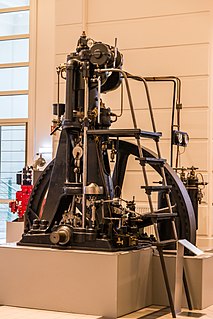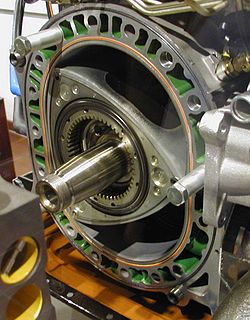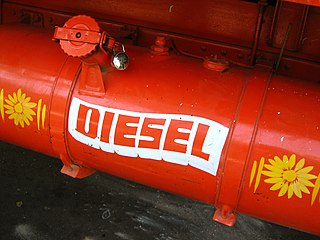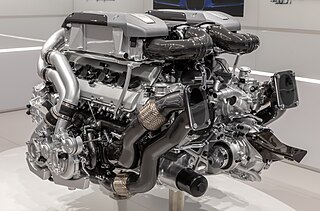Related Research Articles

The diesel engine, named after Rudolf Diesel, is an internal combustion engine in which ignition of the fuel is caused by the elevated temperature of the air in the cylinder due to mechanical compression; thus, the diesel engine is a so-called compression-ignition engine. This contrasts with engines using spark plug-ignition of the air-fuel mixture, such as a petrol engine or a gas engine.

The Wankel engine is a type of internal combustion engine using an eccentric rotary design to convert pressure into rotating motion.

Diesel fuel, also called diesel oil, is any liquid fuel specifically designed for use in a diesel engine, a type of internal combustion engine in which fuel ignition takes place without a spark as a result of compression of the inlet air and then injection of fuel. Therefore, diesel fuel needs good compression ignition characteristics.

A two-strokeengine is a type of internal combustion engine that completes a power cycle with two strokes of the piston during one power cycle, this power cycle being completed in one revolution of the crankshaft. A four-stroke engine requires four strokes of the piston to complete a power cycle during two crankshaft revolutions. In a two-stroke engine, the end of the combustion stroke and the beginning of the compression stroke happen simultaneously, with the intake and exhaust functions occurring at the same time.
A stratified charge engine describes a certain type of internal combustion engine, usually spark ignition (SI) engine that can be used in trucks, automobiles, portable and stationary equipment. The term "stratified charge" refers to the working fluids and fuel vapors entering the cylinder. Usually the fuel is injected into the cylinder or enters as a fuel rich vapor where a spark or other means are used to initiate ignition where the fuel rich zone interacts with the air to promote complete combustion. A stratified charge can allow for slightly higher compression ratios without "knock," and leaner air/fuel ratio than in conventional internal combustion engines.

A petrol engine or gasoline engine is an internal combustion engine with spark-ignition, designed to run on petrol (gasoline) and similar volatile fuels.

A four-strokeengine is an internal combustion (IC) engine in which the piston completes four separate strokes while turning the crankshaft. A stroke refers to the full travel of the piston along the cylinder, in either direction. The four separate strokes are termed:
- Intake: Also known as induction or suction. This stroke of the piston begins at top dead center (T.D.C.) and ends at bottom dead center (B.D.C.). In this stroke the intake valve must be in the open position while the piston pulls an air-fuel mixture into the cylinder by producing vacuum pressure into the cylinder through its downward motion. The piston is moving down as air is being sucked in by the downward motion against the piston.
- Compression: This stroke begins at B.D.C, or just at the end of the suction stroke, and ends at T.D.C. In this stroke the piston compresses the air-fuel mixture in preparation for ignition during the power stroke (below). Both the intake and exhaust valves are closed during this stage.
- Combustion: Also known as power or ignition. This is the start of the second revolution of the four stroke cycle. At this point the crankshaft has completed a full 360 degree revolution. While the piston is at T.D.C. the compressed air-fuel mixture is ignited by a spark plug or by heat generated by high compression, forcefully returning the piston to B.D.C. This stroke produces mechanical work from the engine to turn the crankshaft.
- Exhaust: Also known as outlet. During the exhaust stroke, the piston, once again, returns from B.D.C. to T.D.C. while the exhaust valve is open. This action expels the spent air-fuel mixture through the exhaust valve.

Biodiesel is a form of diesel fuel derived from plants or animals and consisting of long-chain fatty acid esters. It is typically made by chemically reacting lipids such as animal fat (tallow), soybean oil, or some other vegetable oil with an alcohol, producing a methyl, ethyl or propyl ester by the process of transesterification.
A combustion chamber is part of an internal combustion engine in which the fuel/air mix is burned. For steam engines, the term has also been used for an extension of the firebox which is used to allow a more complete combustion process.
Cetane number is an indicator of the combustion speed of diesel fuel and compression needed for ignition. It plays a similar role for diesel as octane rating does for gasoline. The CN is an important factor in determining the quality of diesel fuel, but not the only one; other measurements of diesel fuel's quality include energy content, density, lubricity, cold-flow properties and sulphur content.
Indirect injection in an internal combustion engine is fuel injection where fuel is not directly injected into the combustion chamber. Gasoline engines equipped with indirect injection systems, wherein a fuel injector delivers the fuel at some point before the intake valve, have mostly fallen out of favor to direct injection. However, certain manufacturers such as Volkswagen, Toyota and Ford have developed a 'dual injection' system, combining direct injectors with port (indirect) injectors, combining the benefits of both types of fuel injection. Direct injection allows the fuel to be precisely metered into the combustion chamber under high pressure which can lead to greater power, fuel efficiency. The issue with direct injection is that it typically leads to greater amounts of particulate matter and with the fuel no longer contacting the intake valves, carbon can accumulate on the intake valves over time. Adding indirect injection keeps fuel spraying on the intake valves, reducing or eliminating the carbon accumulation on intake valves and in low load conditions, indirect injection allows for better fuel-air mixing. This system is mainly used in higher cost models due to the added expense and complexity.
Lean-burn refers to the burning of fuel with an excess of air in an internal combustion engine. In lean-burn engines the air:fuel ratio may be as lean as 65:1. The air / fuel ratio needed to stoichiometrically combust gasoline, by contrast, is 14.64:1. The excess of air in a lean-burn engine emits far less hydrocarbons. High air–fuel ratios can also be used to reduce losses caused by other engine power management systems such as throttling losses.
Homogeneous Charge Compression Ignition (HCCI) is a form of internal combustion in which well-mixed fuel and oxidizer are compressed to the point of auto-ignition. As in other forms of combustion, this exothermic reaction releases energy that can be transformed in an engine into work and heat.
In internal combustion engines, water injection, also known as anti-detonant injection (ADI), can spray water into the incoming air or fuel-air mixture, or directly into the combustion chamber to cool certain parts of the induction system where "hot points" could produce premature ignition. In jet engines it increases engine thrust at low speeds and at takeoff.
Hydrogen fuel enhancement is the process of using a mixture of hydrogen and conventional hydrocarbon fuel in an internal combustion engine, typically in a car or truck, in an attempt to improve fuel economy, power output, emissions, or a combination thereof. Methods include hydrogen produced through an electrolysis, storing hydrogen on the vehicle as a second fuel, or reforming conventional fuel into hydrogen with a catalyst.
Lubricity is the measure of the reduction in friction and or wear by a lubricant. The study of lubrication and wear mechanisms is called tribology.
Brake-specific fuel consumption (BSFC) is a measure of the fuel efficiency of any prime mover that burns fuel and produces rotational, or shaft power. It is typically used for comparing the efficiency of internal combustion engines with a shaft output.
The SRM Engine Suite is an engineering software tool used for simulating fuels, combustion and exhaust gas emissions in internal combustion engine applications. It is used worldwide by leading IC engine development organisations and fuel companies. The software is developed, maintained and supported by CMCL Innovations, Cambridge, U.K.

An internal combustion engine is a heat engine in which the combustion of a fuel occurs with an oxidizer in a combustion chamber that is an integral part of the working fluid flow circuit. In an internal combustion engine, the expansion of the high-temperature and high-pressure gases produced by combustion applies direct force to some component of the engine. The force is typically applied to pistons, turbine blades, a rotor, or a nozzle. This force moves the component over a distance, transforming chemical energy into kinetic energy which is used to propel, move or power whatever the engine is attached to. This replaced the external combustion engine for applications where the weight or size of an engine was more important.
Reactivity controlled compression ignition (RCCI) is a form of internal combustion developed at the Engine Research Center, University of Wisconsin, Madison, by the research group of Wisconsin Distinguished Professor Rolf Reitz.
References
- "Promising Delphi 1st-gen Gasoline Direct Injection Compression Ignition engine meeting ultra fuel efficient program targets". Green Car Congress. BioAge Group. 2014-04-17. Retrieved 2016-02-15.
- Johansson, Bengt (2010-04-29). "Partially Premixed Combustion, PPC, for high fuel efficiency engine operation" (PDF). Lund University. Archived from the original (PDF) on 2016-12-22. Retrieved 2016-02-15.
- Johansson, Bengt (2013-06-10). "Partially Premixed Combustion, PPC – Why all diesel engines should be run on gasoline" (PDF). Lund University. Archived from the original (PDF) on 2017-08-30. Retrieved 2016-02-15.
- Lindberg, Austin (2013-11-18). "Hyundai Developing Gasoline-Burning Compression-Ignition Engine". Car and Driver. Hearst Communications. Archived from the original on 2016-02-17. Retrieved 2016-02-15.
- Sellnau, Mark; Foster, Matthew; Hoyer, Kevin; Moore, Wayne; Sinnamon, James; Husted, Harry (2014-04-01). "Development of a Gasoline Direct Injection Compression Ignition (GDCI) Engine" (PDF). SAE International Journal of Engines. SAE International. 7 (2): 835–851. doi:10.4271/2014-01-1300 . Retrieved 2016-02-15.[ dead link ]
- Sellnau, Mark; Moore, Wayne; Sinnamon, James; Hoyer, Kevin; Foster, Matthew; Husted, Harry (2015-04-14). "GDCI Multi-Cylinder Engine for High Fuel Efficiency and Low Emissions" (PDF). SAE International Journal of Engines. SAE International. 8 (2): 775–790. doi:10.4271/2015-01-0834. Archived from the original (PDF) on 2017-05-17. Retrieved 2016-02-14.
- Tunér, Martin (2014-02-28). "State of the art of Partially Premixed Combustion (PPC)" (PDF). Lund University. Archived from the original (PDF) on 2016-02-16. Retrieved 2016-02-14.
- Tunér, Martin (2015-10-22). "Partially Premixed Combustion, PPC, for high efficiency and low emissions" (PDF). Lund University. Archived from the original (PDF) on 2016-01-28. Retrieved 2016-02-14.
Notes
- ↑ Green Car Congress, 2014. Quote: "Delphi has been developing a multi-cylinder engine concept for PPCI combustion with the current US market gasoline (RON91).… A multiple-late-injection (MLI) strategy with GDI-like injection pressures was selected without use of a premixed charge. The absence of classic knock and pre-ignition limits in this process enabled a higher compression ratio of 15. The engine operates “full time” over the entire operating map with partially premixed compression ignition. No combustion mode switching, diffusion controlled combustion, or spark plugs were used. Delphi uses the term Gasoline Direct Injection Compression Ignition (GDCI) in reference to this combustion process."
- ↑ Sellnau et al, 2014.
- ↑ Sellnau et al, 2015.
- ↑ Tunér, 2014. p. 5. Quote: "A loved child has many names
- Gautam Kalghatgi - Saudi Aramco – PPCI, GCI
- Lund – PPC
- Delphi – GDCI
- Eindhoven - PPC
- Wisconsin Madison – PPCI, GCI
- Sandia – PPCI, LTGC"
- ↑ Putrasari, Yanuandri; Lim, Ocktaeck (2019). "A Review of Gasoline Compression Ignition: A Promising Technology Potentially Fueled with Mixtures of Gasoline and Biodiesel to Meet Future Engine Efficiency and Emission Targets". Energies. 12 (2): 238. doi: 10.3390/en12020238 .
- ↑ Johansson, Bengt (2016). "Fuels and Combustion" (PDF). wiley-vch.de. Wiley-VCH. Retrieved 2016-08-29.
The concept is based on injection rather late in the compression stroke and operation with a significant ignition delay. A crude definition of PPC is that all the fuel should be in the cylinder at the time of ignition. This means that start of combustion (SOC) should be after end of injection (EOI). Most often, multiple injections are used with PPC to generate a suitable stratification of fuel/air in the cylinder at the time of ignition
- ↑ Putrasari, Yanuandri; Lim, Ocktaeck (2019). "A Review of Gasoline Compression Ignition: A Promising Technology Potentially Fueled with Mixtures of Gasoline and Biodiesel to Meet Future Engine Efficiency and Emission Targets". Energies. 12 (2): 238. doi: 10.3390/en12020238 .
the lubricity of market gasoline is not adequate to protect today’s fuel injection components, so either the engine components must become more robust or fuel lubricity additives will be needed. Furthermore, the major challenge for GCI is the very small cetane value of gasoline that is usually estimated to be no higher than about 15. This low value leads to long ignition delays and misfires.